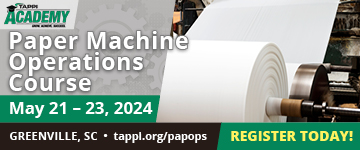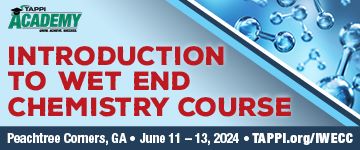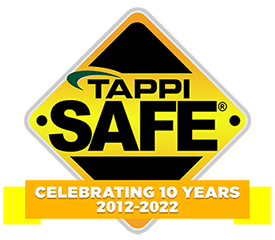 Search
Search
Use the search bar or filters below to find any TAPPI product or publication.
Filters
Content Type
Publications
Level of Knowledge
Collections
Journal articles

Magazine articles

Upscaling of foam forming technology for pilot scale, TAPPI JOURNAL August 2019
ABSTRACT: The need for production cost savings and changes in the global paper and board industry during recent years have been constants. Changes in the global paper and board industry during past years have increased the need for more cost-efficient processes and production technologies. It is known that in paper and board production, foam typically leads to problems in the process rather than improvements in production efficiency. Foam forming technology, where foam is used as a carrier phase and a flowing medium, exploits the properties of dispersive foam. In this study, the possibility of applying foam forming technology to paper applications was investigated using a pilot scale paper forming environment modified for foam forming from conventional water forming. According to the results, the shape of jet-to-wire ratios was the same in both forming methods, but in the case of foam forming, the achieved scale of jet-to-wire ratio and MD/CD-ratio were wider and not behaving sensitively to shear changes in the forming section as a water forming process would. This kind of behavior would be beneficial when upscaling foam technology to the production scale. The dryness results after the forming section indicated the improvement in dewatering, especially when foam density was at the lowest level (i.e., air content was at the highest level). In addition, the dryness results after the pressing section indicated a faster increase in the dryness level as a function of foam density, with all density levels compared to the corresponding water formed sheets. According to the study, the bonding level of water- and foam-laid structures were at the same level when the highest wet pressing value was applied. The results of the study show that the strength loss often associated with foam forming can be compensat-ed for successfully through wet pressing.
Journal articles

Magazine articles

Effects of different ammonium lignosulfonate contents on the crystallization, rheological behaviors, and thermal and mechanical properties of ethylene propylene diene monomer/polypropylene/ammonium lignosulfonate composites, TAPPI Journal January 2020
ABSTRACT: Thermoplastic elastomer (TPE), made from ethylene propylene diene monomer (EPDM) and polypropylene (PP) based on reactive blending, has an excellent processing performance and characteristics and a wide range of applications. However, there are currently no reports in the literature regarding the usage of TPE in making composite boards. In this paper, EPDM, PP, and ammonium lignosulfonate (AL) were used as the raw materials, polyethylene wax was used as the plasticizer, and a dicumyl peroxide vulcanization system with dynamic vulcanization was used to make a new kind of composite material. This research studied the influences of the AL contents on the crystallization behaviors, rheological properties, thermal properties, and mechanical properties of the composites. The results showed that the AL content had a noticeable impact on the performance of the composite board. Accordingly, this kind of composite material can be used as an elastomer material for the core layer of laminated flooring.
Journal articles

Magazine articles

The evolution of reel statistical methods, TAPPI Journal June 2019
ABSTRACT: Multiple statistical methods for calculating the variance partition analysis (VPA) of reel data have existed for decades. In the paper industry, VPA is also commonly known as reel statistics. VPA commonly consists of total variance (TOT) that is then divided into three components: cross direction (CD), machine direction (MD), and residual (RES). A common mathematical procedure is referred to as ANOVA (analysis of variance). TAPPI Standard Test Method T 545 “Cross-machine grammage profile measurement (gravimetric method)” addresses paper testing and includes the ANOVA equations that have also been used to analyze scanning data.In the 1990s, TAPPI published TIP 1101-01 “Calculation and partitioning of variance using paper machine scanning sensor measurements,” which contained simple formulas that were easy to implement and could be used by a nov-ice to generate statistics on a spreadsheet. All involved quality control system (QCS) suppliers agreed to support this common method in their QCS. TIP 1101 was recently revised, and this paper concerns the analysis of data collected from a scanning sensor in a QCS and the creation of a common method for the calculation of reel statistics by TAPPI’s Process Control Division.
Journal articles

Magazine articles

Boiler retrofit improves efficiency and increases biomass firing rates, TAPPI Journal March 2021
ABSTRACT: Domtar’s fluff pulp mill in Plymouth, NC, USA, operates two biomass/hog fuel fired boilers (HFBs). For energy consolidation and reliability improvement, Domtar wanted to decommission the No. 1 HFB and refurbish/retrofit the No. 2 HFB. The No. 2 HFB was designed to burn pulverized coal and/or biomass on a traveling grate. The steaming capacity was 500,000 lb/h from coal and 400,000 lb/h from biomass. However, it had never sustained this design biomass steaming rate. As the sole power boiler, the No. 2 HFB would need to sustain 400,000 lb/h of biomass steam during peak loads. An extensive evaluation by a combustion and boiler technologies supplier was undertaken. The evaluation involved field testing, analysis, and computational fluid dynamics (CFD) modeling, and it identified several bottle-necks and deficiencies to achieving the No. 2 HFB’s biomass steam goal. These bottlenecks included an inadequate combustion system; insufficient heat capture; excessive combustion air temperature; inadequate sweetwater con-denser (SWC) capacity; and limited induced draft fan capacity.To address the identified deficiencies, various upgrades were engineered and implemented. These upgrades included modern pneumatic fuel distributors; a modern sidewall, interlaced overfire air (OFA) system; a new, larger economizer; modified feedwater piping to increase SWC capacity; replacement of the scrubber with a dry electrostatic precipitator; and upgraded boiler controls.With the deployment of these upgrades, the No. 2 HFB achieved the targeted biomass steaming rate of 400,000 lb/h, along with lowered stack gas and combustion air temperatures. All mandated emissions limit tests at 500,000 lb/h of steam with 400,000 lb/h of biomass steam were passed, and Domtar reports a 10% reduction in fuel firing rates, which represents significant fuel savings. In addition, the mill was able to decommission the No. 1 HFB, which has substantially lowered operating and maintenance costs.
Journal articles

Magazine articles

Numerical investigation of the effect of ultrasound on paper drying, TAPPI Journal March 2022
ABSTRACT: The paper drying process is very energy inefficient. More than two-thirds of the total energy used in a paper machine is for drying paper. Novel drying technologies, such as ultrasound (US) drying, can be assessed numerically for developing next-generation drying technologies for the paper industry. This work numerically illustrates the impact on drying process energy efficiency of US transducers installed on a two-tiered dryer section of a paper machine. Piezoelectric transducers generate ultrasound waves, and liquid water mist can be ejected from the porous media. The drying rate of handsheet paper in the presence of direct-contact US is measured experimentally, and the resultant correlation is included in the theoretical model. The drying section of a paper machine is simulated by a theoretical drying model. In the model, three scenarios are considered. In the first scenario, the US modules are positioned in the dryer pockets, while in the second scenario, they are placed upstream of the drying section right after the press section. The third case is the combination of the first and second scenarios. The average moisture content and temperature during drying, enhancement of total mass flux leaving the paper by the US mechanism, total energy consumption, and thermal effect of heated US transducers are analyzed for all cases. Results show that the application of the US can decrease the total number of dryer drums for drying paper. This numerical study is based on the US correlation obtained with the US transducer direct-contact with the paper sample. Thus, future work should include US correlation based on a non-contact US transducer.
Journal articles

Magazine articles

Furnishing autohydrolyzed poplar weakly alkaline P-RC APMP to make lightweight coated base paper, TAPPI Journal February 2022
ABSTRACT: This work investigated the effects of autohydrolysis pretreatment severity on poplar (Populus tomentosa Carr.) woodchips used to make a type of high-yield pulp (HYP) known as preconditioning followed by refiner chemical treatment, alkaline peroxide mechanical pulp (P-RC APMP). It also investigated the ratios for partially replacing sodium hydroxide (NaOH) with magnesium oxide (MgO) in the high-consistency (HC) retention stage of the P-RC APMP process on the obtained HYP’s properties. The results show that the pretreatment severity of autohydrolysis at combined hydrolysis factor (CHF) = 10.77 and the 50 wt% ratio for partially substituting NaOH with MgO were the optimum conditions for making light-weight coated (LWC) base paper. Compared to the conventional P-RC APMP, the optimized P-RC APMP had similar bulk and higher tensile, burst, and tear indices, as well as opacity, but a slightly lower ISO brightness. When the optimized P-RC APMP and commercial softwood bleached sulfate pulp (SBKP) were blended to make LWC base paper, the most favorable pulp furnish was comprised of 50% optimized P-RC APMP and 50% commercial SBKP. The obtained LWC base paper handsheet had better bulk, and its other properties could also meet the require-ments of LWC base paper.
Journal articles

Magazine articles

Commercially relevant water vapor barrier properties of high amylose starch acetates: Fact or fiction?, TAPPI Journal September 2021
ABSTRACT: Starches have recently regained attention as ecofriendly barrier materials due to the increased demand for sustainable packaging. They are easily processable by conventional plastics processing equipment and have been utilized for oil and grease barrier applications. While starches have excellent oxygen barrier properties and decent water barrier properties at low relative humidity (RH), they are moisture sensitive, as demonstrated by the deterioration of the barrier properties at higher RH values. Starch esters are chemically modified starches where the hydroxyl group of the starch has been substituted by other moieties such as acetates. This imparts hydrophobicity to starches and has been claimed as a good way of retaining water vapor barrier properties of starches, even at high RH conditions. We studied the water vapor barrier properties of one class of starch esters, i.e., high amylose starch acetates that were assumed to have good water vapor barrier properties. Our investigations found that with a high degree of substitution of hydroxyl groups, the modified starches did indeed show improvements in water vapor response as compared to pure high amylose starch films; however, the barrier properties were orders of magnitude lower than commercially used water vapor barriers like polyethylene. Even though these materials had improved water vapor barrier response, high amylose starch acetates are likely unsuitable as water vapor barriers by themselves, as implied by previous literature studies and patents.
Journal articles

Magazine articles

Editorial: The changing face of the coated paper industry, TAPPI JOURNAL January 2018
Editorial: The changing face of the coated paper industry, TAPPI JOURNAL January 2018
Journal articles

Magazine articles

Impact of fiber structure on edge-wicking of highly-sized paperboard, TAPPI JOURNAL August 2018
Impact of fiber structure on edge-wicking of highly-sized paperboard, TAPPI JOURNAL August 2018
Magazine articles

Technology utilization in mills, TAPPI JOURNAL, March 2000, Vol. 83(3)
Technology utilization in mills, TAPPI JOURNAL, March 2000, Vol. 83(3)






